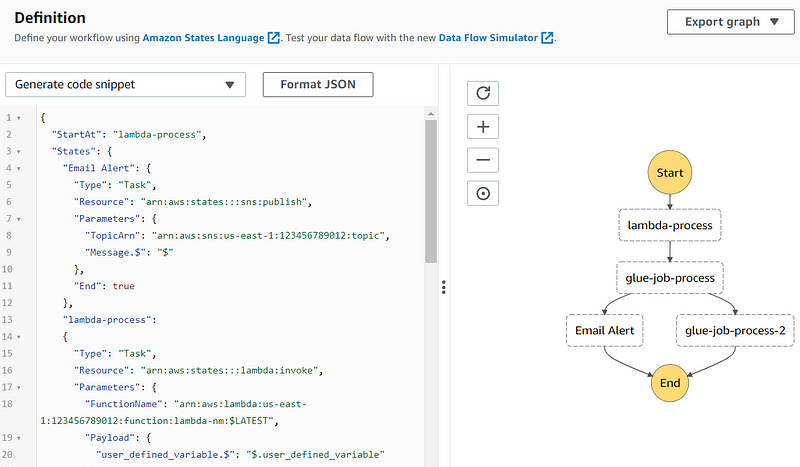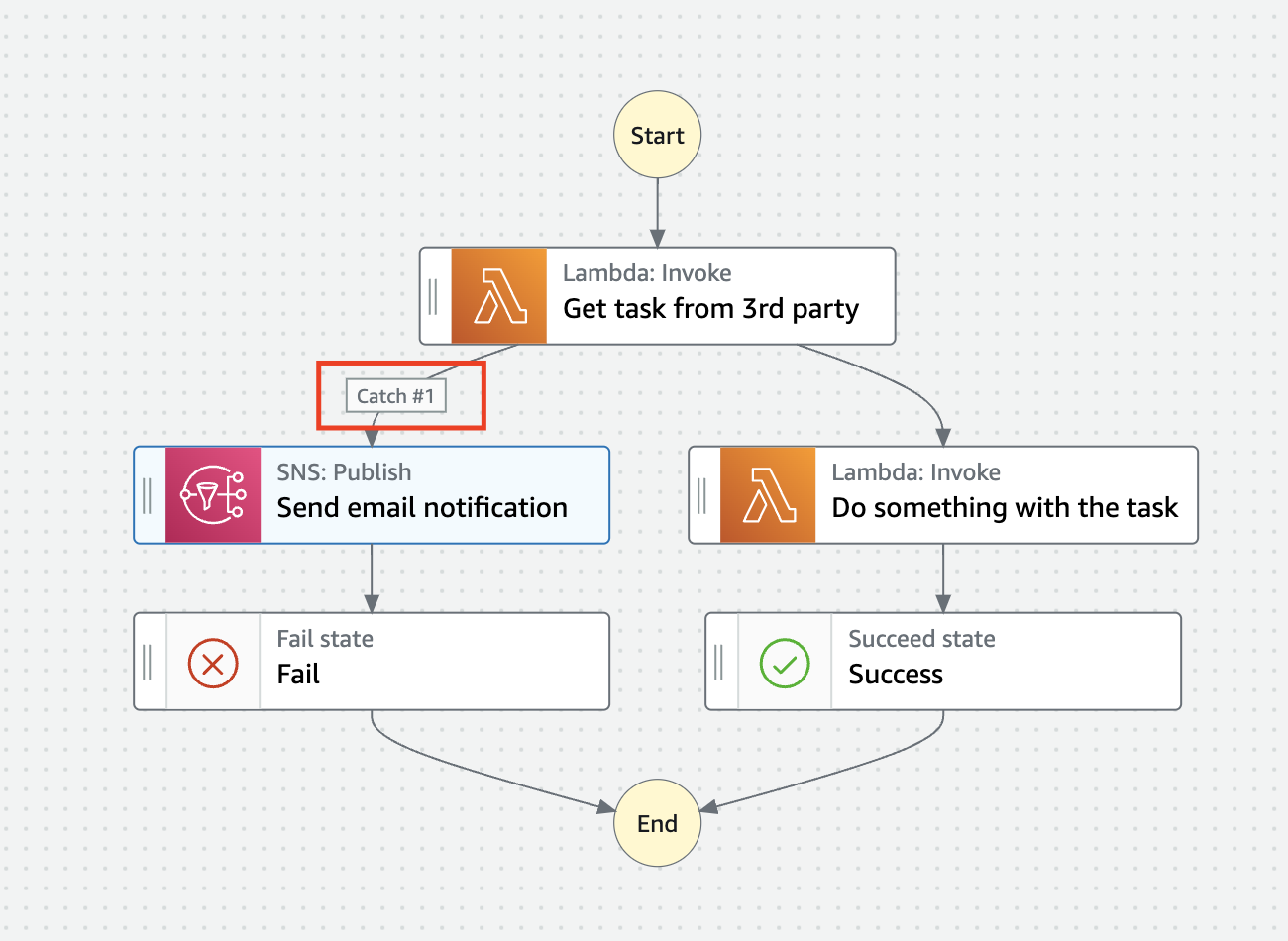AWS Step Functions
1. Introduction
Amazon Step Functions is a fully managed serverless orchestration service that helps you build and run distributed applications and microservices using visual workflows. By defining a state machine—a series of discrete steps called states—Step Functions lets you coordinate multiple AWS services (like Lambda, Batch, ECS, and more) without managing the underlying infrastructure. This enables rapid application development with built-in error handling, retry logic, and visual debugging tools.
2. Core Capabilities
Step Functions allows you to define state machines, each describing a set of states and transitions in JSON. At runtime, AWS uses your state machine definition to generate a visual representation, providing real-time tracking of each workflow’s progress.

Key features:
- Sequence and Parallel Actions: Execute multiple tasks in a defined order or in parallel branches.
- Conditions and Timeouts: Branch logic based on data or time constraints.
- Built-in Error Handling: Automatically retry failed tasks or catch and redirect errors.
- Task Integration: Call AWS Lambda, start AWS Batch jobs, send events to Amazon SNS or Amazon SQS, run Amazon EMR, AWS Glue, or Amazon SageMaker jobs, and more.
- Human Approval Steps: Extend long-running workflows by adding steps requiring manual confirmation.
- Maximum Duration: Standard workflows can run for up to one year, making them suitable for extended processes, while Express workflows handle shorter-lived tasks (up to five minutes).
3. Workflow Patterns
3.1. Standard Workflows
Standard workflows are the original Step Functions offering. They provide:
- Maximum Duration: Up to one year of execution time.
- Execution History: A detailed execution log of each step.
- Exactly-Once Processing: Each workflow runs in a durable and consistent manner.
- Pricing Model: Billed according to the number of state transitions.
They are ideal when:
- You require human approval steps or extended waiting periods.
- Your workflow must maintain a rich history of every transition for auditing.
3.2. Express Workflows
Express workflows handle high-volume, short-lived processes. They offer:
- Maximum Duration: Five minutes.
- Scalability: Start over 100,000 executions per second.
- Pricing Model: Charged based on runtime duration and memory usage (similar to AWS Lambda).
- At-Least-Once Processing: Internally optimized for large-scale event-driven patterns.
- Logging: Detailed state tracking is typically sent to Amazon CloudWatch Logs, rather than stored as an execution history.
They are ideal when:
- You need massively parallel workloads requiring near-real-time scalability.
- You do not need extensive history or year-long orchestration.
3.3. Synchronous vs. Asynchronous Invocations
When using Express workflows, you can start them either synchronously or asynchronously:
- Synchronous: The caller waits for the workflow to complete and then receives the output. Useful when you want immediate results or require explicit error handling at the caller.
- Asynchronous: The workflow starts, and the caller receives a success acknowledgment right away without waiting. Suitable for fire-and-forget scenarios or when the workflow’s outcome can be polled or delivered to another system.
4. Handling Errors and Monitoring

Step Functions natively supports automatic retries and catch blocks within your state machine definition. For example, you can configure a task to retry on specific error types a given number of times before failing permanently.
When permanent failures do occur, you can configure rules so that an event is emitted to Amazon EventBridge. A typical design includes:
- EventBridge Rule detects the failed Step Functions execution.
- SNS Topic is invoked to send alerts (email, SMS, etc.) to operators.
This approach offers proactive visibility into long-running or critical workflows.
5. Common Use Cases
- Microservices Orchestration: Chain multiple microservices to handle parallel tasks, condition-based flows, and error handling in a single, transparent workflow.
- Data Processing Pipelines: Trigger big data jobs in AWS Glue or Amazon EMR, waiting for them to complete, and then proceed based on success or failure.
- Machine Learning Model Training: Automate data preprocessing, training jobs, and post-processing tasks with a single orchestrator, reducing manual overhead.
- Batch and Container Operations: Launch AWS Batch or Amazon ECS/Fargate tasks, with Step Functions managing job states and waiting for completion.
6. Pricing and Limits
-
Pricing:
The free tier includes 4,000 state transitions per month. Beyond that, you pay per 1,000 state transitions (approximately $0.025 per 1,000). For Express workflows, pricing is based on the number and duration of executions. -
Limits:
Some hard limits include a maximum 1MB payload per request and up to 25,000 state transitions per execution for Standard workflows. Most limits (like concurrent executions or state machine count) can be increased via a support request.
7. Conclusion
Amazon Step Functions simplifies the creation, execution, and monitoring of complex workflows by abstracting the underlying orchestration logic. Whether you’re building microservice applications, data pipelines, or integrating human-in-the-loop approvals, Step Functions provides a scalable, resilient, and easy-to-use platform—backed entirely by AWS’s robust ecosystem.
For more detailed information, consider the following official resources:
-
AWS Step Functions Developer Guide:
Explore detailed documentation, best practices, and examples.
AWS Step Functions Developer Guide -
AWS Step Functions Overview Page:
Get started and learn about key features directly on the AWS website.
AWS Step Functions Overview -
White Papers:
For practical examples and architectural guidance, see the AWS white paper “Create a Serverless Content Syndication Pipeline with AWS Step Functions.”
Create a Serverless Content Syndication Pipeline with AWS Step Functions (PDF)